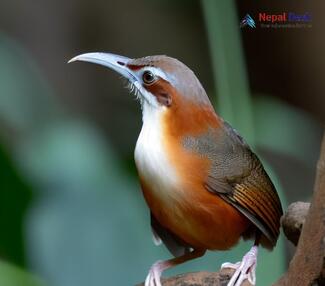Nestled amidst the picturesque landscapes of Nepal, you'll find a diverse range of fascinating bird species, including the Rusty-cheeked Scimitar Babbler (Pomatorhinus erythrogenys). Known for its beautiful appearance and captivating song, this unique bird has caught the attention of bird enthusiasts and wildlife photographers alike. In this article, we'll delve into the details of this stunning bird and its presence in Nepal.
Appearance and Characteristics
The Rusty-cheeked Scimitar Babbler boasts a striking appearance that distinguishes it from other birds in its family. As its name suggests, the most prominent feature of this babbler is its rusty cheeks, which contrast with its otherwise earth-toned plumage. The bird's long, downward-curved bill is reminiscent of a scimitar – a type of sword with a curved blade – giving it an extraordinary silhouette.
Measuring around 19-22 cm in length and weighing about 38-51 grams, the Rusty-cheeked Scimitar Babbler has a robust build. Its plumage features shades of brown and grey, with darker upperparts that blend seamlessly into lighter underparts. With a white throat encircled by a black crescent-shaped band, this babbler's contrasting colors make it easy to identify in the field.
Habitat and Distribution
The Rusty-cheeked Scimitar Babbler inhabits a variety of environments throughout Southeast Asia. Its range extends from northeastern India through Bhutan and southern China, stretching eastwards into Myanmar, Thailand, Laos, and Vietnam. In Nepal, you're likely to encounter this enigmatic bird in forested areas at elevations between 600–3,000 meters above sea level.
Preferring dense undergrowth, the Rusty-cheeked Scimitar Babbler is often found in deciduous and evergreen forests where it can find ample cover. In Nepal, these birds are commonly spotted in protected areas such as Langtang National Park, Sagarmatha National Park, and Annapurna Conservation Area.
Behavior and Diet
Living primarily on the ground, the Rusty-cheeked Scimitar Babbler is an agile forager. Beneath the forest floor's foliage, it uses its long bill to dig out insects, larvae, and other invertebrates – its primary food source. The Babbler may also supplement its insectivorous diet with seeds and other plant material.
When it comes to communication, this species is known for its melodious song. Its distinctive vocalizations consist of a series of loud whistles, trills, and chatters that can carry long distances through its wooded environment.
Conservation Status
Though not globally threatened at present, habitat loss remains a concern for the Rusty-cheeked Scimitar Babbler. Deforestation and increasing human pressures on natural resources could negatively impact this species' habitat and population numbers. There's an ongoing need for continued conservation efforts in Nepal to ensure that both the Rusty-cheeked Scimitar Babbler and countless other native species can thrive for years to come.
In conclusion, the Rusty-cheeked Scimitar Babbler is a captivating bird that plays a vital role in Nepal’s diverse ecosystem. For birders visiting this enchanting country, catching a glimpse of this distinct bird is undoubtedly a memorable experience worth seeking out.

